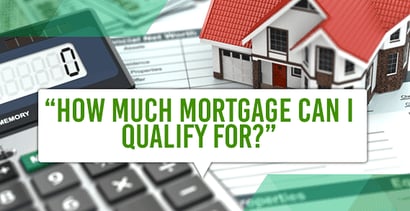

Becoming a homeowner is an exciting experience and marks a new beginning with limitless potential. And watching any of the dozens of home-buying shows peppering the airways these days is enough to inspire almost anyone to run out and purchase a house, or at least wonder, “How much mortgage can I qualify for?” Unfortunately, the process isn’t quite as simple — or speedy — as it appears on television.
For the vast majority of folks, purchasing a new home will involve obtaining a mortgage loan from a bank, credit union, or other type of lender. The mortgage provider will determine the amount of money they are willing to lend you, and the total amount you can spend on your new home will be based on the size of your mortgage. In the following article, we’ll take a look at the factors that can impact how much mortgage you may qualify for, explore how to calculate traditional mortgages, and look at other options such as FHA loans.
Factors Impacting Qualifying Amounts | Calculating Traditional Mortgages | FHA Loans
1. What Factors Impact How Much Mortgage I Qualify For?
According to the Mortgage Bankers Association, the average mortgage loan is $239,265. Even if the house you have your eye on is half the national average, you’re going to be looking for a six-figure loan from your bank or another lender — and they’re not going to simply hand it over because you asked nicely. The lender needs to know more about you — and, in particular, your financial habits — before they cut you that giant check.

Mortgage lenders will consider a number of factors with your application including your income, current obligations, and credit history.
After you apply for a mortgage loan, the lender will evaluate your current finances, going through a complex process designed to determine your potential risk as a borrower. Essentially, the lender wants to estimate the likelihood that you’ll be able (and willing) to repay your loan as agreed.
While every lender will likely have their own specific set of criteria for qualifying applicants, they’ll all use the same basic factors to determine your overall risk, including your income, current obligations, and credit history. The lender will also take into account the price of the home you are looking to purchase, and weigh that into its evaluation of your ability to handle the increased level of debt.
Your Income
Your income is central to the calculation for how much mortgage you can qualify for. In general, the higher your income, the larger the mortgage you will be able to obtain (though other factors will impact the overall loan amount).
When determining your income level for your application, you should consider your total income before taxes. This includes your base salary, plus any commissions, bonuses, overtime, and tips. You should also include secondary sources of income such as Social Security, rental income, investment income, alimony, and child support. If you are applying with a spouse or other co-borrower, be sure to include the total income for both parties.
Although not included as a part of your actual income, your total assets will also impact your overall mortgage approval chances and the amount of mortgage you receive. These assets can include the cash in your current bank accounts, such as checking and savings accounts, and any stocks, bonds, or mutual funds you have, as well as any real estate you already own.
Your Current Obligations
While the money you have coming in is important, so, too, is how much of that money is going right back out. If you are already struggling to meet your current obligations, or are likely to struggle if a new mortgage loan is added to the mix, lenders will be less likely to extend you a large loan.
The types of obligations considered by lenders include typical debts, such as a monthly car payment and your current credit card payments (excluding balances you pay in full every month), as well as student loans, alimony, and child support payments. It isn’t necessary to include basic living expenses, like groceries and utility payments, in your calculations.
In addition to your debts, you’ll need to include your monthly housing expenses. This is the rental payments or PITI payments of your primary residence. However, don’t include your current rent or mortgage payment if the new mortgage will take its place. If you own any secondary or rental properties for which you owe money, however, they will need to be taken into account.
Your ability to meet your current debt obligations is determined via your Debt-to-Income (DTI) ratio. This is calculated by dividing your total monthly obligations by your monthly income. As an example, imagine a hypothetical homebuyer, Erwin, has a total monthly income (before taxes) of $4,000, and his obligations and expenses (shown in the table below) total $1,300. Dividing his obligations by his income, Erwin’s DTI would be 32.5%.
| Obligation | Amount |
|---|---|
| Car payment | $300 |
| Credit cards | $200 |
| Student loans | $200 |
| Housing Expenses | $600 |
| TOTAL: | $1,300 |
The actual DTI a lender requires of its applicants will depend on both the lender and the type of loan (eg, conventional, FHA, etc.). The lower your DTI, the less risk you present as a borrower, and the better your chances of receiving a favorable loan offer. In addition, a DTI that is too high may cause you to be rejected altogether.
For most conventional loans, Fannie Mae requires that the borrower’s DTI be 36% or below, although the DTI can be as high as 45% if the borrower meets the specific credit score and reserve requirements. That said, most lenders prefer to see a DTI that doesn’t exceed 28%.
Your Credit History
Of course, an important part of any credit risk evaluation will be to take a good look at your credit history. When you apply for a mortgage, the lender will pull at least one — but potential all three — of your consumer credit reports for a thorough going-over.
In part, the lender will use your credit report to determine your current debt obligations as part of its DTI calculation, but it will also be evaluating other aspects of your history. In particular, lenders will look for any warning signs of risky financial behavior, including missed payments, accounts in collections, and bankruptcies.
Many lenders will use your numerical credit score, which is calculated using data from your credit report, as a measure of your overall credit health. The most frequently used credit score provider in the US is the Fair Isaac Corporation (FICO) and the FICO Score 8 the most widely used credit score — everywhere except the mortgage industry. According to myFICO, the majority of the mortgage industry actually uses the older FICO Score 2, 4, and 5 models to calculate scores.
Applicants with poor credit histories and low credit scores will be more likely to be turned down for a mortgage. If approved, these applicants will most likely have to pay higher interest rates and fees.
Your Potential PITI
Another major factor in qualifying for a mortgage loan is the monthly PITI — principal, interest, taxes, and insurance — of the property you want to purchase. If the PITI of your potential property will increase your DTI above an acceptable level, you may not qualify for the loan.
When determining the PITI of a property, the principal and interest refer to the monthly mortgage loan payments. The principal payment will depend on the actual amount borrowed, which is the purchase price of the house minus any down payment. The mortgage interest rate is generally based on the applicant’s creditworthiness; those with higher credit scores will see lower interest rates.

The monthly PITI — principal, interest, taxes, and insurance — is a major factor in qualifying for a mortgage.
In addition to the principal and interest, your PITI amount will incorporate the monthly cost of your property taxes, which will vary by county, as well as any homeowners association fees.
Your monthly homeowner’s insurance premium will also be included in your PITI total. Homeowners insurance costs generally depend on state or region, with those in areas more at risk of property damage — say the hurricane-prone Florida coast — often paying higher insurance rates.
The final piece of the PITI puzzle doesn’t actually apply to everyone: private mortgage insurance (PMI). Those whose down payment is less than 20% of the total purchase price of the property will likely be required to obtain PMI, which helps protect the lender in the case of default on the loan.
For conventional mortgages, the PMI can be canceled when the amount owed on the loan falls below a set threshold. FHA mortgages retain the PMI for the life of the loan.
Your Down Payment
The down payment you are able to put down is part of what determines the Loan-to-Value (LTV) ratio of the purchase, representing the equity you’ll automatically have in the property. If you put down $40,000 of your $200,000 home purchase, you will have 20% initial equity in the home and an 80% LTV ratio.
Lower LTV ratios represent less risk for the lender, so conventional mortgage lenders will require a down payment of at least 5% — and many prefer at least 20% of the purchase price as a down payment. That means if you have your eye on a $200,000 house, you’ll need at least $10,000 to qualify for a mortgage for that home.
On the other hand, FHA mortgages can be obtained with a down payment as low as 3.5% of the purchase price if the applicant has a credit score of at least 580. Those with lower credit scores aren’t automatically turned down for an FHA loan, but may have to put down 5% or more and have a lower DTI.
2. How Do I Calculate the Amount for Traditional Mortgages?
While a number of mortgage types exist, the most common and basic type of mortgage is a traditional, or conventional, mortgage. Unlike other types of mortgages, such as FHA or VA loans, conventional mortgages are not guaranteed or otherwise insured by a government entity. As such, traditional mortgages represent a greater risk for the lender, and will generally have the most stringent credit qualifications and highest down payment requirements.
The simplest way to get an idea of the size of the conventional mortgage you may qualify for is to use an online mortgage calculator, like this simple version from Chase, or this more comprehensive version from My Mass Mortgage. A mortgage calculator can make the process as simple as filling in a few numbers or adjusting a slider to see your options.
For a quick estimate, you can calculate your potential DTI using different PITI amounts to see where you will hit the acceptable threshold. Using hypothetical Erwin as another example, his current DTI is 32.5% with housing expenses set to $600. That means he can increase his housing expenses before hitting the maximum DTI threshold of 36%.
Recalling that we said Erwin’s income was $4,000 a month and his total expenses, minus housing costs, equals $700, his potential DTIs would be:
| Potential PITI | Total Obligations | Potential DTI |
|---|---|---|
| $600 | $1,300 | 32.5% |
| $650 | $1,350 | 33.75% |
| $700 | $1,400 | 35% |
| $750 | $1,450 | 36.25% |
| $800 | $1,500 | 37.5% |
In this example, Erwin should aim for a house with a PITI of $700 or lower to ensure he doesn’t exceed the maximum DTI limit for conventional loans. The lower his DTI, however, the better his chances of receiving a favorable loan offer.
3. How Do I Determine the Amount for an FHA Mortgage?
In contrast to a conventional mortgage, FHA mortgages — or, more accurately, FHA-backed mortgages — are mortgage loans insured by the Federal Housing Administration. Essentially, the FHA guarantees that the lender won’t lose its money (up to 90% of the LTV) if the borrower defaults on the loan.
You can get a good estimate of how much of an FHA-backed loan you will qualify for using the same online calculators you would for a conventional mortgage estimate, with two main differences. First, because FHA-backed loans are less risky for the lender, applicants may be able to put down as little as 3.5%, so you may be able to manage the down payment for a slightly larger purchase price than going the conventional route.
The other difference lies in the fact that, as government-insured loans, the FHA-backed mortgages are limited in size based on the location and type of property. Typically, FHA loan limits are calculated at 115% of the county’s median home price and can only be obtained for properties between one and four units in size.
- America's largest mortgage lender
- The entire process is completed online
- Options for new mortgages and refinancing existing mortgages
- Award-winning customer service and cutting-edge digital platforms
- More than 90% of clients would recommend us
- See application, terms, and details
| Interest Rate | In Business Since | Application Length | Reputation Score |
|---|---|---|---|
| Varies | 1985 | 5 minutes | 9.5/10 |
- Best for cash-out refinance
- Utilize your home equity with America's #1 lender
- eClosing allows customers to close electronically, greatly speeding the process
- A+ rating with the BBB
- Receive cash for home improvements, college tuition, or paying off debt
- 24/7 access to your loan through the Rocket Mortgage app
- See application, terms, and details
| Interest Rate | In Business Since | Application Length | Reputation Score |
|---|---|---|---|
| Varies | 1985 | 5 minutes | 9.5/10 |
- Get today's mortgage rates from the top mortgage lenders and banks
- Easily compare and choose mortgage lenders with no obligations or fees
- Review current mortgage rates side by side
- Pick mortgage lenders that meet your specific needs
- Compare rates from pre-qualified and approved mortgage lenders — 100% online, 100% free
- See application, terms, and details.
| Interest Rate | In Business Since | Application Length | Reputation Score |
|---|---|---|---|
| Varies | 1979 | 4 minutes | 8.5/10 |
Not every lender will actually offer FHA-backed mortgage loans, and those that do may have their own requirements above and beyond the basic rules set forth by the FHA. Make sure to research your chosen lender to determine if they offer FHA loans and, if so, what their particular requirements may be.
Make Sure You Buy Within Your Budget
No matter how tempting those pricey homes may look on the home-buying shows, bursting your budget to buy a bigger house can leave you in an unmanageable financial situation in the long run. Regardless of the type and size of mortgage you qualify for, never purchase a home more expensive than what you can afford. Having a huge house may sound nice but if it places undue stress on your budget, it’s not worth it in the long run.
You also don’t want to wipe out your savings — or, worse, pillage your retirement account — to finance your down payment. Always make sure you have enough savings to cover emergencies (like a leaky roof) before you take on the debt that is a six-figure mortgage loan.
Advertiser Disclosure
BadCredit.org is a free online resource that offers valuable content and comparison services to users. To keep this resource 100% free for users, we receive advertising compensation from the financial products listed on this page. Along with key review factors, this compensation may impact how and where products appear on the page (including, for example, the order in which they appear). BadCredit.org does not include listings for all financial products.
Our Editorial Review Policy
Our site is committed to publishing independent, accurate content guided by strict editorial guidelines. Before articles and reviews are published on our site, they undergo a thorough review process performed by a team of independent editors and subject-matter experts to ensure the content’s accuracy, timeliness, and impartiality. Our editorial team is separate and independent of our site’s advertisers, and the opinions they express on our site are their own. To read more about our team members and their editorial backgrounds, please visit our site’s About page.







